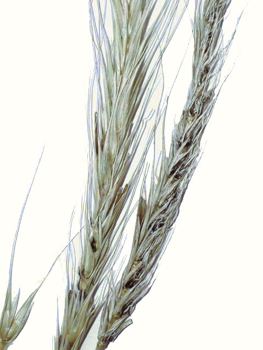Diseases
Ustilago tritici (Pers.) Rostr. - Loose Smut of Rye.
Synonym.
U. vavilovi Jacz.Systematic position.
Class Basidiomycetes, subclass Teliobasidiomycetidae, order Ustilaginales, family Ustilaginacea, genus Ustilago.Biological group.
Biotroph.Morphology and biology.
U. tritici infects mainly wheat. The fungus easily passes from wheat to rye and vice versa. Also species of Hordeum, Aegilops, Elymus, Agropyron, Elytriga, and Haynaldia may be infected. Loose Smut manifests itself at inflorescence emergence. As a result, the spike is entirely destroyed except for rachilla, and a mass of olive-black spores that show up in a colonized spike in place of seeds. Usually the spores are formed in the lower part of ear. Upper spikes may be uninfected, but seeds are not formed there. The Loose Smut fungus survives as a mycelium within the embryo of wheat seeds. The pathogen is activated when the seed germinates, and expands toward the growing point of the plant. When an ear begins to form, the fungus invades the whole tissue except for the rachilla. Mycelium form teliospores, and the ears produce black mass of teliospores in place of grains. The spores are spread by wind onto neighboring healthy plants and infect plant flowers. The windborne teliospores fall on the open flower stigmas and geminate. Upon germination the teliospores produce a haploid basidium (promycelium), but basidiospores (sporidia) are not formed. The fusion of compatible monokariotic cells occurs. Copulated basidial cells yields infectious dikaryotic hyphae, which penetrate the ovaries. Seed buds are infected, but grains containing fungus hyphae in embryo are developed. Teliospores of U. tritici are spherical, echinulate, olive-black, 5 to 9 . in diameter.Distribution.
U. tritici as wheat pathogen is registered in different countries of Europe, Asia, America, and Australia with wheat cultivation. On rye the Loose Smut occurs in the USA. In the former USSR the disease occurs on rye in regions with warm climates, i.e., in Middle Asia, Bielorussia, Ukraine, Cis- and Trans-Caucasia, Volga Basin region and the Far East of Russia. At the same time this species is found on wheat in all regions where wheat is cultivated. Its transmission from wheat to rye is possible everywhere.Ecology.
The fungus may develop at 7-8.C to 30-33.C. Temperatures 22. to 27.C and humidity 56-95% are optimal for both teliospore germination and mycelium development.Economic significance.
In infected fields damage may be appreciable, because the number of depressed plants is much greater than the number of diseased ears. However, Loose Smut of Rye does not represent an essential danger now because of its limited distribution. Increasing wheat infection by Smut may pose danger for rye. The disease has a potential to cause significant yield losses, if the control practice is ignored. Control measures include seed treatment.Reference citations:
Anonymous. 1999. Smuts of rye, oats and barley. Zashchita rastenii i karantin, 7: 31. (In Russian)Karatygin I.V. 1986. Smuts of cereal crops. Leningrad: Nauka. 112 p. (In Russian)
Levitin M.M., Tuterev S.L. 2003. Fungal diseases of cereals crops. Zashchita rastenii i karantin, 11: 77. (In Russian)
© Dmitriev A.P.


